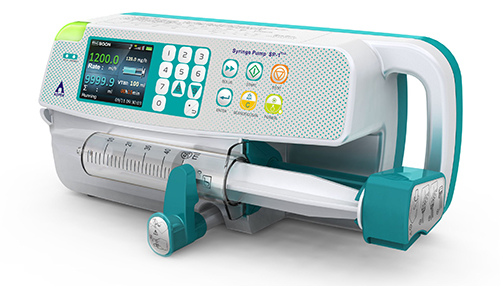Available Results For Syringe Pump
- Laryngoscope
- Patient Monitor
- Infusion Pump
- Syringe Pump
- Mammography
- Syringe Pump
- Blood And Fluid Warmer
- Infusion Pump
- Oxygen Flow Meter
- Infusion Pump
- Stretcher
- Syringe Pump
Syringe Pump Suppliers, Manufacturers & Dealers In India
A syringe pump, also recognized as a syringe driver, is an infusion pump that helps distribute an exact quantity of liquids, whether nutrients or medicines, into the patient’s body in a controlled manner. They are not just used in medical locations such as a clinic, nursing homes, or hospitals, but also during exploration studies. A syringe pump made by Syringe Pump Manufacturers is a motor-driven machine that has inherent software to program the degree and extent of the liquid. A syringe infusion pump has a step motor that thrusts the syringe plunger that expels the liquids through the needle into the patient’s body. Contingent to the requirements, a syringe pump machine may be intended to be still and set up at the patient’s bedside or movable/ wearable. They also have a liquid withdrawal capacity and can billet numerous syringes contingent on the application.
Types of Syringe Pumps:
There are two wide-ranging kinds of pumps supplied by Syringe Pump suppliers: Laboratory syringe pumps and Medical infusion pumps.Laboratory Syringe Pump: These are machines used in research laboratories for submissions that need very accurate liquid deliveries. Laboratory research pumps naturally handle smaller capacities and offer additional features that medical pumps do not have. Such as pervade and extract syringe pumps, multi needles syringe pumps, OEM unit syringe pumps, and high-pressure syringe pumps. The OEM unit syringe pump and high-pressure syringe pump have been found valuable in manufacturing applications recently.
- Medical Infusion Pump: These are machines used to distribute controlled quantities of liquids such as nutrients, medications, and blood to patients. This kind of infusion pump can be used for in vivo analysis, treatment, and investigation.
How to use a Syringe pump?
1. Shower your hands and put on sterilized gloves
2. Take the infusion linked to the pump, a 10ml saline flush, and malt gauze to the patient’s bedside
3. Again, check patient individuality and drug aversions with the prescription table before linking the infusion
4. Again, settle patient agreement and perception of the procedure
5. Check the IV cannula location for any signs of contagion/phlebitis: any soreness, pain, or bulge around the cannula site (do not connect the infusion if contagion/phlebitis is suspected- the cannula may need to be detached and sited elsewhere)
6. Safeguard the patency of the IV cannula: clean the center with a malt swab for 30 seconds and let dry for 30 seconds/eliminate the cap using the disease-free technique, attach the syringe with salty flush, fasten off any other infusion that may be running, vaccinate the saline into the cannula making unquestionable it vaccinates easily with no resistance and doesn’t reason the patient any pain nor cause any soreness or puffiness to surrounding tissues.
7. Check the compatibility of the infusion you are about to commence with any other infusions running through the same cannula (halt any other infusion that is not companionable with the medicine you are about to infuse or wait for the infusion already linked to being finished. if this is not likely, a second IV cannula may need to be introduced at a different location)
8. Using a disease-free non-touch method, eliminate the cap from the end of the fermentation line, safeguarding that the exposed end is not dirtied
9. Elevate the patient’s arm and eliminate the cap from the cannula or clean the current hub with a malt swab for 30 seconds and let dry for 30 seconds and ascribe the infusion line.
10. Make sure the capacity to be pervaded and the infusion rate are set properly as prepared
11. Fortify the pump to the trolley/drop stand
12. Begin the fermentation running
13. Check the patient’s ease and for any instant effects/signs of an opposing reaction
14. Register on the drug table: the date, the time of beginning infusion, your autograph, and the signature of the capable person who checked the medications with you earlier.








